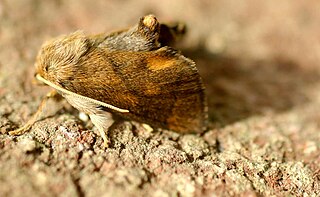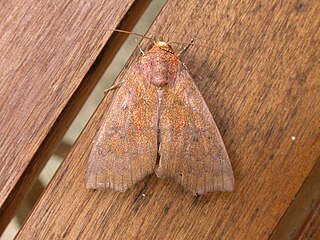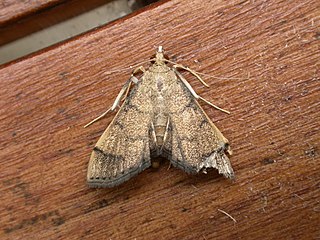
Attacus atlas, the Atlas moth, is a large saturniid moth endemic to the forests of Asia. The species was described by Carl Linnaeus in his 1758 10th edition of Systema Naturae.

The flannel moths or crinkled flannel moths are a family of insects. They occur in North America and the New World tropics.

The Drepanidae are a family of moths with about 660 species described worldwide. They are generally divided in three subfamilies, which share the same type of hearing organ. Thyatirinae, previously often placed in their own family, bear a superficial resemblance to Noctuidae. Many species in the drepanid family have a distinctively hook-shaped apex to the fore wing, leading to their common name of hook-tips.

The Pyraloidea are a moth superfamily containing about 16,000 described species worldwide, and probably at least as many more remain to be described. They are generally fairly small moths, and as such, they have been traditionally associated with the paraphyletic Microlepidoptera.

The Limacodidae or Eucleidae are a family of moths in the superfamily Zygaenoidea or the Cossoidea; the placement is in dispute. They are often called slug moths because their caterpillars bear a distinct resemblance to slugs. They are also called cup moths because of the shape of their cocoons.

Callidulidae, the only known family of the superfamily Calliduloidea, is the family of Old World butterfly-moths, containing eight genera. They have a peculiar distribution, restricted to the Old World tropics of Southeast Asia to Australasia and Madagascar. The three subfamilies exhibit both day- and night-flying behaviour.

Ennominae is the largest subfamily of the geometer moth family (Geometridae), with some 9,700 described species in 1,100 genera. Most species are fairly small, though some grow to be considerably large. This subfamily has a global distribution. It includes some species that are notorious defoliating pests. The subfamily was first described by Philogène Auguste Joseph Duponchel in 1845.

Drepaninae are by far the largest subfamily of the Drepanidae moths. While it is usually split into two tribes, Drepanini and Oretini, its internal systematics and phylogeny are not well resolved.

Casuariclystis is a genus of moths in the family Geometridae. It contains only one species, Casuariclystis latifascia, which is widespread. The range includes Borneo, the Andamans, Fiji, Rotuma Island, Vanuatu, New Caledonia, Hong Kong, the Ogasawara Islands, Kenya, Mauritius, Aldabra, and the Seychelles. The habitat consists of coastal areas, dry heath forests, limestone forests, oceanic islands, and dry secondary forests.
Scintillithex is a genus of moths in the family Geometridae. It contains only one species, Scintillithex glaucisparsa, which is found on Borneo and Peninsular Malaysia.

Pseuderosia is a genus of moths belonging to the subfamily Drepaninae.

Herochroma baibarana is a species of moth of the family Geometridae first described by Shōnen Matsumura in 1931. It is found in China, Taiwan, Sri Lanka, the north-eastern parts of the Himalayas, Peninsular Malaysia, Sumatra and Borneo.

Asthenini is a tribe of geometer moths under subfamily Larentiinae first described by Warren in 1893. The tribe has been combined with Eupitheciini in the past, most notably by Jeremy Daniel Holloway in his work The Moths of Borneo.

Condica illecta is a moth of the family Noctuidae. It is found in both the Indo-Australian and Pacific tropics, including Borneo, Hawaii, Hong Kong, India, New Guinea, the Society Islands, Taiwan and Queensland and New South Wales in Australia. It is also present in New Zealand.

Anticarsia irrorata, the owl moth, is a species of moth in the family Noctuidae. It is native to the Old World tropics.

Pogonopygia pavida is a species of moth of the family Geometridae. It is found in the Himalaya, Taiwan, Japan, Indonesia and Peninsular Malaysia.

Anomis nigritarsis is a species of moth of the family Erebidae. It is found in Sri Lanka, India, China (Hainan), Taiwan, Borneo, Java, Sulawesi, the Moluccas, Queensland, New Caledonia, the Solomon Islands, Vanuatu, Fiji, Samoa and Tonga.

Omiodes indicata, the bean-leaf webworm moth or soybean leaf folder, is a species of moth of the family Crambidae. It is found from Florida to Texas, the West Indies and Mexico to South America, Cameroon, the Comoros, the Democratic Republic of Congo, La Réunion, Madagascar, Mauritius, Nigeria, Saudi Arabia, the Seychelles, South Africa, India, Borneo and Australia (Queensland).
Pseuderosia cristata is a moth in the family Drepanidae. It was described by Snellen in 1889. It is found in Sundaland.
Pseuderosia humiliata is a moth in the family Drepanidae. It was described by Francis Walker in 1861. It is found on Borneo.

















